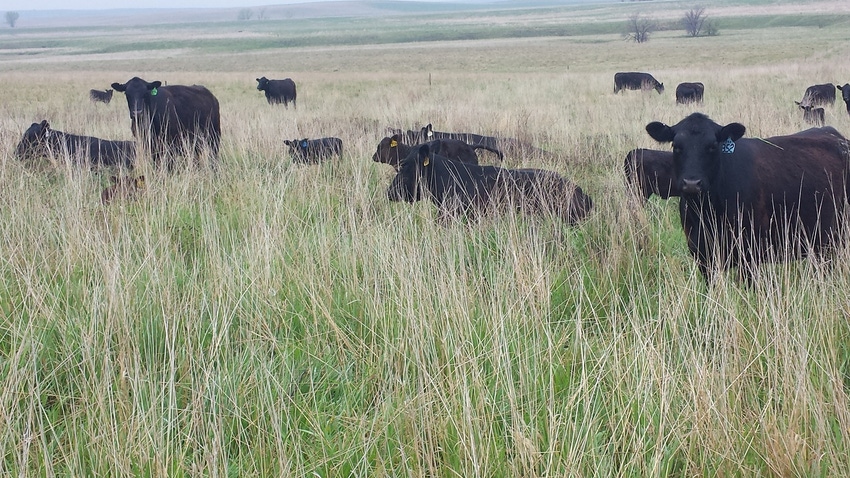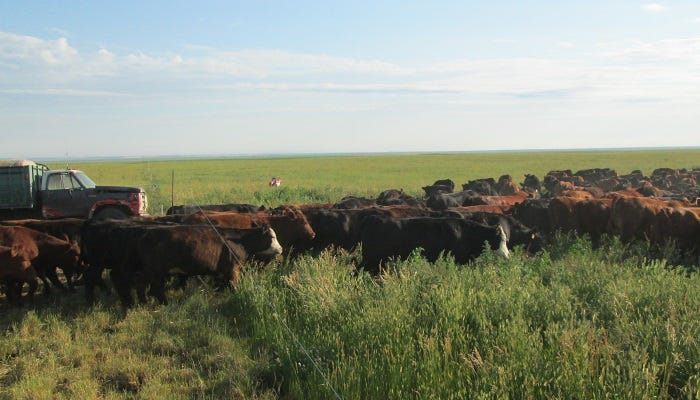July 13, 2019

Historical farming and livestock-raising methods generally take nutrients from soil and don’t add them back, yet the best way to regain soil function is with properly applied livestock impact.
Jeff Goodwin of the Noble Research Institute, Ardmore, Oklahoma, says this animal-based method of managing to improve soil health is the new frontier for agriculture.
“Most farmers and ranchers have not kept soils healthy. We’ve focused on managing above-ground production, not paying attention to what’s happening below ground," he says. "The Natural Resources Conservation Service has focused on physical and chemical aspect of soils, pH, soil structure, soil texture and so forth, all of which are important, but until the past few years we haven’t focused on the soil’s biological activity."
“There’s no longer enough organic matter,” he adds. "Carbon in organic matter is food for soil organisms. If we keep plowing, we keep releasing the carbon. This is why we now try to use reduced tillage in cropping systems, and in pastures we try to stop haying and graze them instead."
One key is that soil must be well covered. Bare ground allows soil temperature to increase, damaging biological activity and losing soil life and soil organic matter. Our soils are degraded because we’ve lost many of the microbes, Goodwin explains.
Doug Peterson, Iowa/Missouri regional soil health specialist for NRCS, says his foundational experience with regenerative grazing comes from his own operation, with 250 pairs plus another 100 contract cows.
“Allan Savory taught me about animal impact," Peterson says. "This is a phenomenal tool to heal and build up worn-out soils.”
He adds: “Soils in this country have been seriously degraded. Here in northern Missouri ... pre-European-settlement, soils were probably close to 8% organic matter. We’ve mined organic matter out of them with tillage and overgrazing. Cropland is down to about 1.5% and well managed pastures about 2.5 to 3.5%.
“In my training in agronomy and soil science we were taught that it takes hundreds of years to build or restore soil. But we started seeing some interesting things with intensive grazing and trampling, adding carbon to the soil surface, feeding the soil biology. We now know we can do this a lot quicker.”
Peterson says there are many great examples of people who have built soil. Some producers have restored their soil organic matter to 6% and even 8% in just a few years.
"Historically, we thought all soil organic matter came from plants," Peterson says. "Now research shows that maybe as much as half the carbon-based organic matter is a living organism."
"Trampling is a way to feed the soil biology," he adds. "Any time we remove the soil’s food source via crops or haying, we’ve taken something away. Even if we feed the hay back on the same land, we don’t get full benefit. We might keep the minerals in the same field, but there’s no way we can spread it across that field as uniformly as by grazing. If we don’t leave nutrients for the soil biology, we can’t keep things functioning optimally."
Peterson says by keeping a taller canopy longer, soil temperatures stay much cooler, and suffer less evaporation. Soil cover has long been understood by soil scientists to prevent erosion and slow runoff, but this idea of soil cover as food for soil life is new.
With tall plants, depending on management, cattle tend to trample more than they eat, Peterson says.
“We must rethink our idea of waste. Most people feel that if they don’t completely use a pasture, they are poor managers, but this ‘waste’ is an investment in the future, putting enough material on the ground to protect the soil and feed the soil organisms.”
Taller forage plants also put down deeper and bigger roots, thereby providing more opportunity to create sugars and starches in the plants and encouraging the underground exchange of nutrients with soil life.

Regenerating soil in Canada
Art McElroy, who farms in southern Saskatchewan, started seeding some of his farm back to grass in 1998, and changes in his grazing now have grass spreading to cover bare soil and more.
“When we came here in 1996 we had only one-half of a percent organic matter in the first soil tests. There wasn’t enough for biological life to live on."
"We began to think about the critters below ground, versus livestock above ground," he adds. "We realized continuous cropping was better than summer fallow but would not build soil organic matter and biological life. In 2006 we decided to seed the entire place back to grass."
Along with their own cows, they started custom grazing 1,200 yearlings to add manure to the soil. In 2008 they started putting 1,200 head on 2.7 acres for just a few hours, moving them up to six times a day.
“Today the real progress with our grazing is because many of our pastures are only grazed 2 to 3 hours each year, with long periods of rest. Some of this land goes to seed every year.”
McElroy asked the Soil Carbon Coalition to take soil samples to measure the level of organic matter/carbon in his soil. In cooperation with this group, every five years in the future he will do a test to see what kind of advances he's making in storing carbon in the ground.
About the Author(s)
You May Also Like




